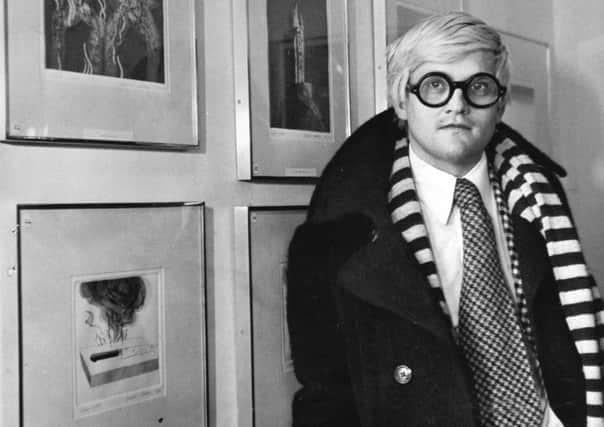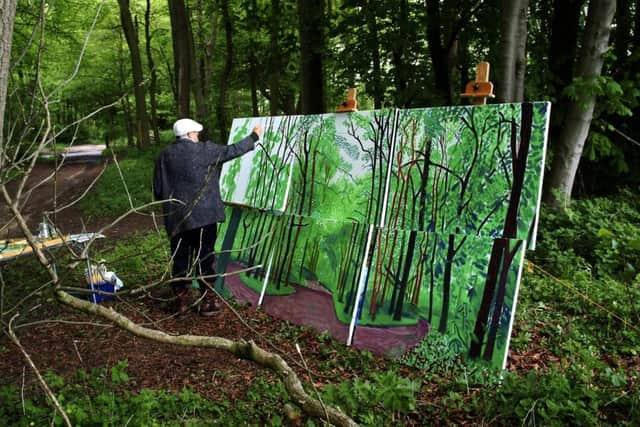Goliath of the gallery


It’s a mantra that Hockney continues to recite even as he approaches his 80th birthday and it’s his dedication to his craft which Sykes believes resulted in record tickets sales for his new exhibition at Tate Britain. That and the sheer joy which so much of his work exudes.
“Like most artists, David’s work reflects his life and his mood,” says Sykes. “However, while he does have a depressive side and while there are inevitably periods which are quite dark, in general there is a real feeling of optimism about them. That’s what I think people react to. It’s impossible to walk through an exhibition of his work and not come out smiling. That’s not something that can be said for every artist.”
Advertisement
Hide AdAdvertisement
Hide AdTate Britain’s epic exhibition covers six decades of Hockney’s work. It is his first retrospective since 1988 and some were surprised that before the doors even opened 20,000 tickets had been sold. Sykes was not one of them. He was a teenager when he first met Hockney who was then being championed by the Kasmin Gallery, which fast became a hub for London’s cultural glitterati.


“My mother was friends with Lord Dufferin who had put up the money for the place and every so often I used to hang out there. I was always rather astonished by David’s appearance and his incredibly bright clothing, but even then his work was something very special. I remember asking my mother for one of his paintings, which had a price tag of a couple of hundred pounds. I didn’t get it, but she did buy me one of his etchings, which I have always treasured.”
Sykes went on to become a journalist and photographer and while he occasionally ran into Hockney at gallery openings or exhibitions it wasn’t until 2004 that he really started to get to know him.
“When I first told people that I wanted to write a biography of David Hockney everyone said: ‘You are wasting your time, he will never do it’. But I am a great believer in being persistent. The first time I asked him, he said ‘I’m busy right now, come back to me in three months’. Three months later he said: ‘I’m going away, ask me in three weeks’. And so it went on. Eventually I said: ‘Look David, I have to get on with my life, so I just need a yes or a no. I was amazed.” Having agreed to the project, Hockney laid his life and his work bare. As well as opening up his own archives, he helped Sykes contact friends and family and what emerged was a picture of a man who has only ever been concerned by the work rather than the fame it brought.
Advertisement
Hide AdAdvertisement
Hide Ad“He knew what he wanted to do from being about four years old. He never even considered another career. His brother remembers one day when they were driving through Bradford and went past an elaborate set of gates. When they got back home, David got out his pencils and recreated them so precisely. He was only six or seven years old but even then he had an incredible talent for draughtsmanship.


“Back then, if you were bright you only got to do art for at most an hour a week. David soon realised that if you were at the bottom of the class, you got to do it a whole lot more, so he pretty much stopped trying in every other subject just so that he could be labelled a dunce and get time in the art department.”
It was time that served him well. After a spell studying at Bradford College of Art, Hockney headed for London and he took the work ethic which had been instilled in him by his parents with him.
“He was always the first person in college and the last person to leave and that’s really what got him noticed. Not long after he arrived he decided that he needed to brush up on his drawing skills and thought a skeleton which was hanging up in the studio would be the perfect subject. He spent six weeks on two giant works. They were incredibly intricate and word soon began to spread. While he has never set out to be the centre of attention somehow he can’t help it.”
Advertisement
Hide AdAdvertisement
Hide AdWhile it was Yorkshire that formed Hockney and London that provided the springboard for his career in art, it was California that made his name. It was the winter of 1963 that he boarded the plane for Los Angeles and the swimming pools that were to feature in dozens of paintings made an instant impression as he came into land.
“He was completely thrilled by the place and he has always been honest about what drew him there. It was the boys. Or at least initially that was the attraction. Another thing that is hugely admirable about David is that he has never hid his sexuality. He grew up in an era when being gay was considered a crime and while he never felt the need to hide who he was, California offered a freedom he didn’t necessarily have here. He was like a kid in a sweet shop, but the place was also hugely influential on his work and I’ve always thought it quite funny that it was a lad from Bradford who made the swimming pools of LA famous.”
For a long time it seemed that Hockney had found a permanent home in the Hollywood Hills. However, he never severed his ties with Yorkshire and when his friend Jonathan Silver, who had been responsible for breathing new life into Salts Mill, was diagnosed with pancreatic cancer, Hockney caught the first plane he could back to Britain.
“When the disease worsened he decided to stay,” says Sykes. “He converted the loft of his mother’s house in Bridlington into a large studio and at least every couple of days he would drive over to Wetherby to visit Silver. It was a journey which took him over the Wolds and it was during those drives that he fell in love with the Yorkshire landscape again.
Advertisement
Hide AdAdvertisement
Hide Ad“He began to remember the beauty of this remote area with its rolling chalky hills, little valleys and red brick farmhouses. Whenever he got to Silver’s house he would ask if there was anything he could do for him and he always used to say: ‘Why don’t you paint East Yorkshire?’”
At the time the art world was dominated by the Young British Artists and amid the likes of Damien Hirst and Tracey Emin it seemed there was little room for Hockney. The reviews of a late 1990s exhibition of vase paintings weren’t kind, with one critic echoing the thoughts of many when he said “our most famous painter just doesn’t seem to be able to paint any more”.
“Hockney has never bothered what other people think, but certainly A Bigger Picture was a very clear statement that he hadn’t gone away,” says Sykes of the Royal Academy exhibition in 2012 which showcased his vast canvases of East Yorkshire landscapes alongside drawings he had created on an iPad. “He had become completely captivated by his home county again and for 10 years he became a very familiar figure around the Wolds, driving around in his little van, stopping by the roadside whenever the mood took him.”
That period of happiness was brought to an abrupt end in 2013 with the death of his assistant Dominic Elliott. An inquest found that following a 24-hour drugs and drink binge, the 23-year-old walked into the bathroom of Hockney’s Bridlington home and drank from a bottle of drain cleaner. He died while on the way to hospital.
Advertisement
Hide AdAdvertisement
Hide Ad“Dominic’s death had a huge impact,” says Sykes. “At the time he was also recovering from the effects of a minor stroke and so he decided to move back to Los Angeles. He didn’t make any new work for about two years, but he is coming back to life again, so much so he was quite reluctant to have a retrospective. It was the idea that it’s the kind of tribute only afforded to artists once their career is over and he has so much more to say.”
As Hockney says himself: “I’m still too excited about what I will do tomorrow. You don’t retire doing this. You just do it till you fall over. It’s an interesting life. My mind is occupied. That’s what you want at my age, but I always wanted it. In fact, I’m greedy for it.”
Hockney The Biography has just been released in paperback. Published by Century, each volume costs £15.